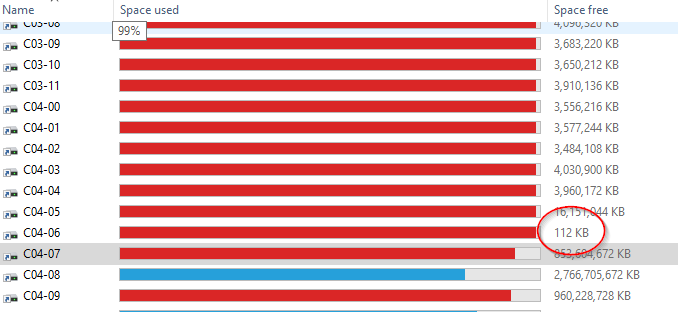I filled a 16 TB, WD Elements USB drive, with nothing other than K32 plots, and have 327 MB remaining.
Hooray for me!
Do I win the coveted “Most efficient use of storage space” award?
I filled a 16 TB, WD Elements USB drive, with nothing other than K32 plots, and have 327 MB remaining.
Hooray for me!
Do I win the coveted “Most efficient use of storage space” award?
How many plots? I get 145 k32’s onto a XFS formatted 16TB on Ubuntu, leaving just a couple of GB short another plot.
How did you format the drive?
I have 5 of those drives, all formatted as NTFS.
On two of the drives, I stuffed 150 K32 plots.
On three of the drives, I stuffed 148 K32 plots.
Until I just checked, I just assumed that all would have the same number of plots.
Apparently, the plots do differ in size, resulting in sometimes squeezing more plots on a drive, when it just happens that many those plots are a bit smaller than average.
All five of the drives have the same amount of free space, when empty (well, not down to the last byte – but close). So it is just a matter of luck how it turned out.
I imagine you could manually manage moving plots around, and perhaps manage to squeeze one more plot on a drive once in a while. Not worth the time and effort to me.
Ironically, the drive where I thought I squeezed out the most efficient use of space is one that I got only 148 plots. So it is really about getting the highest number of plots on a drive, and no so much about whether X GBs are still remaining.
Here’s my record for a 16tb drive - although I’m kinda cheating and using Chives lol

Since you are on windows (NTFS…) would you mind doing a sort on file size in File Explorer and give your smallest k.32 plotsizes?
It’s a bit strange or funny I think.
I have an Unraid server with xfs formatted disks. On there is a smb share with plots. I can approach those plots via a share on windows and have the share passed on to a Ubuntu VM running Chia.
Unraid itself roughly rounds of file sizes to 109GB, the Ubuntu VM show ~108.7GB, Windows File Explorer 106.284.943kB or 106.3GB…
The 108.7 GB sounds about right, given chia official info states k.32 plots are around 101.4GiB, equalling 108.8GB.
Maybe Windows is somehow more efficient in packing the same amount of bits into hdd sectors than Linux. But the Ubuntu VM and Windows file explorer are looking at the same physical file/hdd/sectors in the shared disk…
Well, some more googling ahead…
164 plots fit in my WD 18TB drives, I keep the size of one plots free on each drive for disk repairs.
Consider that this isn’t really necessary for the type of data that you are storing. This data isn’t like any other data you’ve ever stored - you don’t care about it cause you can always plot more. So: if you ever need to run a disk repair, you could simply delete an existing plot, run the repair, then plot another one to fill that last bit again. Leaving free space on your drive, however small, is leaving mojos on the table. ![]()
From how many of my 16 TB USB Elements drives to you want the stats?
I will give you the command prompt’s output from “dir /os”, which will list the plots, sorted by size.
The drive has its own reserved area for spares. These errors are called grown defects. The drive reallocates(repairs) at an LBA level which is 4KB in size. I wouldn’t see the need to keep a plot space free as the drive won’t see the failure at the 106GB size just the 4KB size. It doesn’t care/know the file size, just what LBAs the host has asked to read. Hope that makes sense
Sorry, but I got my file count wrong.
Each of my 16 TB USB Elements drives has 147 K32 files.
My mistake is that I did not notice that I had one or two small, lingering txt files in the directory, that I inadvertently added to the file count total.
No problem;-)
But 147 is still great, compared with 145 on Linux XFS formatted 16TB.
The NTFS allocation unit size for the Element’s drive, set by the factory, is 4K, by the way.
Also note that the formatted, available space in the drive is just a few thousand bytes short of:
16,000,000,000,000 bytes.
To compare apples to apples, please see how many “bytes” are free on an empty 16 TB drive that you are using, formatted with XFS.
Toshiba MG08 16TB drive plots
srv-ubu-01:/boot$ find /mnt/disk03 -name “*.plot” | wc -l
147
Toshiba MG09 18TB drive plots
srv-ubu-01:/boot$ find /mnt/disk08 -name “*.plot” | wc -l
165
filesystem is ext4 on ubuntu 20
Thanks for this info.
That’s 146 and 164 plots then, I get 145 and 164 on the same drives with xfs formatting.
So ext4 must be a bit more efficient than xfs.
I guess it has to do with reserved space. I don’t know if you can tune xfs like ext4 on that level.
It appears xfs has reserved space, but for internal housekeeping only and not for user root as ext standard reserves 5%.
xfs reserves 5% or 8192 file system block, whichever is less. For a big capacity disk its allways the 8192 block that limits reserved space.
And it’s not tunable! But a lot less than the standard 5% of 16/18TB luckily;-)